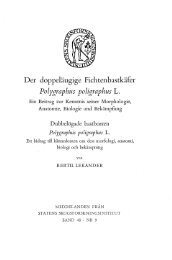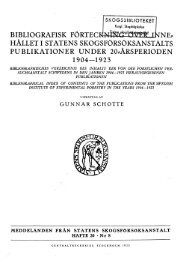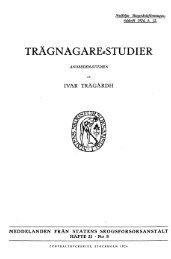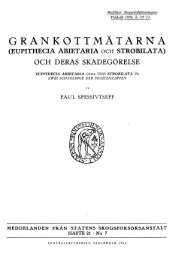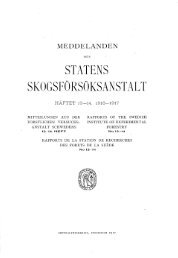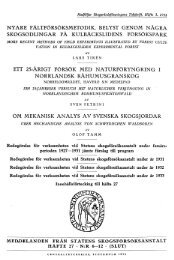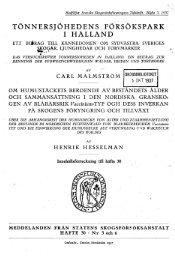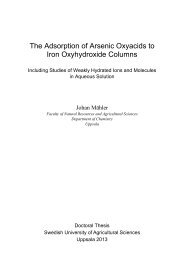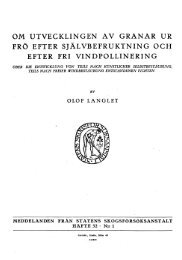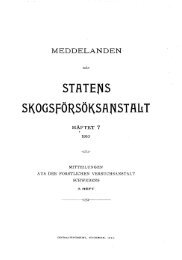Grönsöö park och trädgård 1820-1925 - Epsilon Open Archive - SLU
Grönsöö park och trädgård 1820-1925 - Epsilon Open Archive - SLU
Grönsöö park och trädgård 1820-1925 - Epsilon Open Archive - SLU
Create successful ePaper yourself
Turn your PDF publications into a flip-book with our unique Google optimized e-Paper software.
<strong>Grönsöö</strong> Park and Gardens <strong>1820</strong>-<strong>1925</strong>. The cultivation, experiences and<br />
documentation of three family members in relation to contemporary<br />
cultural heritage values<br />
Abstract<br />
<strong>Grönsöö</strong> Manor on the island of Grönsö south-east of Enköping was built in the 1610s. The<br />
first garden was probably laid-out in 1622 as an orchard. The Manor is a notable cultural<br />
heritage due to its well-preserved corps-de-logi, rich interior collections and grand<br />
surroundings. Besides being a representative for aristocratic estates still existing today, <strong>Grönsöö</strong><br />
is used as a private home, run by the Ehrenheim family since <strong>1820</strong>. The <strong>park</strong> is renowned for<br />
its unbroken continuity, but has nonetheless undergone major changes. The structures from the<br />
17th and 18th centuries are mainly well preserved whilst many buildings and structures from the<br />
19th century and early 20th century have disappeared. This thesis aims to explore the<br />
characteristics of the <strong>park</strong> during the little known period of <strong>1820</strong>-<strong>1925</strong>.<br />
The <strong>Grönsöö</strong> archives offer plant lists from 1840-1842 written by Reinhold Fredrik von<br />
Ehrenheim, as well as a rich autobiographical material written by his grandson Erik von<br />
Ehrenheim. These sources were analysed to shed light on structures and plants now gone, but<br />
also on the personal use of the garden and <strong>park</strong>, as well as private motives for preserving<br />
<strong>Grönsöö</strong> for future generations. Drawings and literature have also been analysed so as to<br />
understand the progress of the fruit orchards run by Erik’s wife Alice von Ehrenheim in the<br />
early 1900s.<br />
The study emphasizes that the former family members did not only focus on the imposing<br />
structures of the <strong>park</strong>. Instead, the <strong>park</strong> was used as an arena where buildings, animals, fences,<br />
fruits, flowers, fantasies as well as seasonal changes were important parts. The water, the shore<br />
and the islands and islets were all parts of a rich entity for both private use and social events. In<br />
comparison with today's <strong>park</strong>, the memoranda tell a different, intimate and complex story<br />
which mirrors the former owners' strong attachments to <strong>Grönsöö</strong>. The plant lists exhibit<br />
hundreds of curious species, many of them imported from Hamburg as brand new ornamental<br />
plants at that time. They were the apple of the owner's eyes as well as a significant part of a<br />
short-lived garden fashion in the mid nineteenth century. A remarkable garden heritage is the<br />
today still ongoing fruit growing, orchards generally being a fading tradition as a commercial<br />
crop in this region. Alice von Ehrenheim's modern growing methods and experiences contributed<br />
not only to <strong>Grönsöö</strong>'s fruit harvest but to national pomological knowledge.<br />
Keywords: <strong>Grönsöö</strong>, garden history 19 th century, ornamental plants, plant import, cultural<br />
heritage, plants lists, autobiographical memoranda, von Ehrenheim, fruit growing<br />
Author’s address: Anna Tandre, Department of Urban and Rural Development, slu, Box 7012,<br />
SE-750 07 Uppsala, Sweden<br />
E-mail: Anna.Tandre@sol.slu.se





